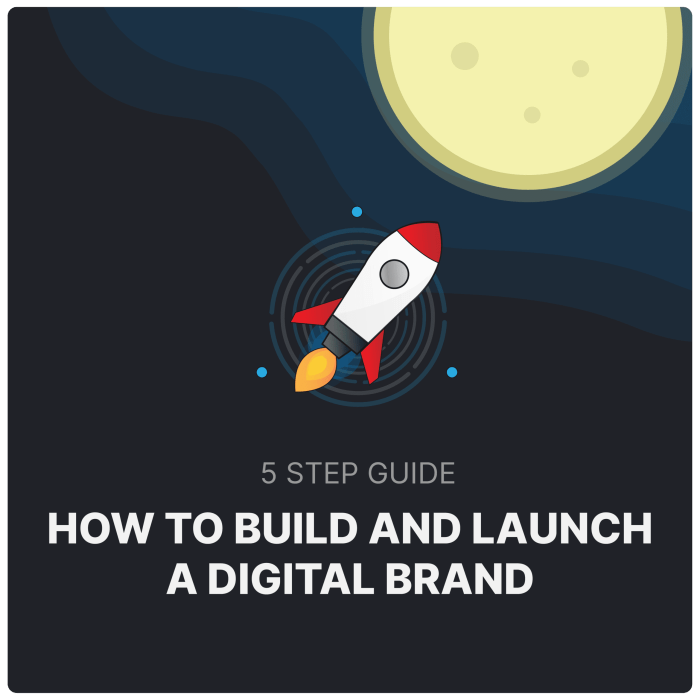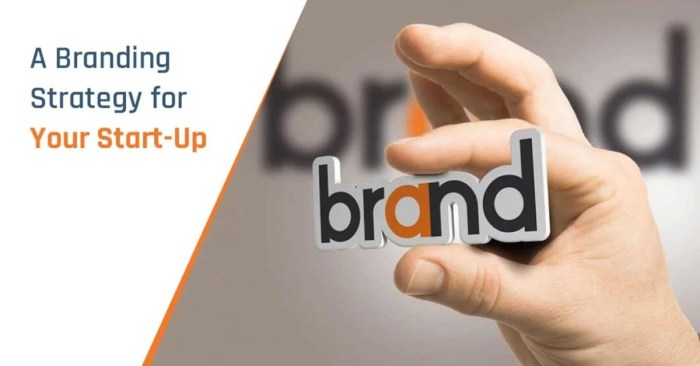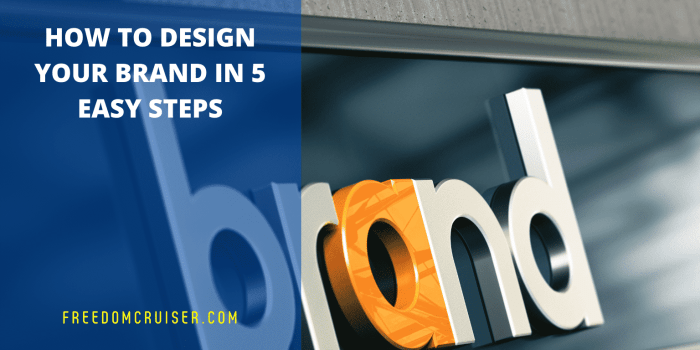Launching a startup requires more than just a great product; it demands a compelling brand identity. A strong brand resonates with your target audience, builds trust, and fosters loyalty. This guide provides a structured approach to crafting a brand that not only stands out but also thrives in the competitive marketplace. We’ll explore the crucial steps, from defining your core values to implementing a consistent brand strategy across all platforms.
From crafting a captivating brand story to designing visually appealing marketing materials, we’ll delve into the practical aspects of brand development. We’ll also discuss the importance of a comprehensive brand style guide and the ongoing effort required to maintain brand consistency. This isn’t just about logos and colors; it’s about building a cohesive brand experience that resonates with your customers and drives business growth.
Defining Your Brand Identity

Crafting a compelling brand identity is paramount for any startup aiming to resonate with its target audience and establish a strong market presence. A well-defined brand identity goes beyond a logo; it encompasses the personality, values, and story that connect with customers on an emotional level. This section Artikels key steps to solidify your startup’s brand identity.
A strong brand identity provides a clear and consistent message across all platforms, fostering trust and loyalty. It helps differentiate your startup from competitors, making it easily recognizable and memorable. This process involves introspection, market research, and creative development to build a brand that accurately reflects your startup’s essence and aspirations.
Brand Personality Questionnaire
To effectively define your brand’s personality, a structured questionnaire is beneficial. This questionnaire should guide startup founders in articulating the brand’s core characteristics. Consider questions that explore attributes such as: Is your brand playful or serious? Traditional or innovative? Sophisticated or approachable? Luxury or budget-friendly? The answers to these questions will help paint a picture of your brand’s personality. Further questions might explore ideal customer demographics and lifestyle choices to ensure brand personality aligns with the target audience. For example, a question like “If your brand were a person, who would it be and why?” encourages a deeper understanding of the brand’s character. Another question could be: “What three words best describe the feeling your brand evokes?”.
Mood Board Development
A mood board serves as a visual representation of your brand’s core values and aesthetic. This is a collection of images, colors, textures, and typography samples that evoke the desired feeling and atmosphere. For example, a startup focusing on sustainable practices might include images of lush forests, recycled materials, and earthy color palettes. A tech startup, on the other hand, might feature sleek lines, futuristic imagery, and vibrant, modern colors. The mood board should be a collaborative effort, allowing for diverse perspectives to contribute to the brand’s visual identity. The goal is to create a cohesive and evocative visual representation that encapsulates the brand’s essence.
Brand Voice Options and Comparison
Developing three distinct brand voice options allows for a comparative analysis of their effectiveness. Consider these examples: Option 1: Formal and professional, suitable for a corporate environment. Option 2: Casual and friendly, ideal for a younger, more relatable audience. Option 3: Playful and humorous, appropriate for a niche market that appreciates a lighthearted approach. Each option should be tested against the target audience through surveys or focus groups to determine which resonates most effectively. The results will inform the selection of the optimal brand voice that accurately conveys the brand’s personality and connects with the intended customers. Metrics like engagement and conversion rates can be used to evaluate each voice’s success.
Brand Story Development
The brand story encapsulates the startup’s mission, vision, and unique selling proposition (USP). The mission statement defines the startup’s purpose and goals, while the vision statement Artikels its aspirations for the future. The USP highlights what differentiates the startup from its competitors. For example, a sustainable clothing startup’s mission might be “To create ethically sourced and environmentally friendly clothing,” its vision could be “To become a leading brand in sustainable fashion,” and its USP might be “Using only recycled materials and employing fair trade practices.” A well-crafted brand story should be compelling, authentic, and resonate with the target audience, creating a connection that extends beyond the product or service itself. This narrative provides context and meaning, building brand loyalty and trust.
Visual Brand Development

Creating a strong visual identity is crucial for a startup’s success. It’s the first impression your brand makes, influencing how customers perceive your value proposition and building lasting recognition. This section Artikels the key elements of visual brand development, guiding you through the process of crafting a cohesive and memorable brand aesthetic.
Logo Design Concepts
A well-designed logo is more than just a pretty picture; it’s a visual representation of your brand’s personality and values. It should be memorable, versatile, and easily recognizable across various platforms. The following table compares three logo variations for a hypothetical startup, “EcoFlow,” a company specializing in sustainable energy solutions.
| Variation | Description | Strengths | Weaknesses |
|---|---|---|---|
| Variation A | A stylized leaf incorporating the “EF” monogram within its design. | Clean, modern, and easily scalable; effectively communicates the “eco” aspect. | May be too abstract for immediate brand recognition; potential for confusion with other similar logos. |
| Variation B | A simple, bold “EcoFlow” wordmark in a custom typeface. | Highly legible and versatile; suitable for various applications. | Lacks visual memorability; may appear generic if the typeface isn’t unique enough. |
| Variation C | An abstract representation of flowing energy, incorporating green and blue gradients. | Visually striking and memorable; conveys the “flow” aspect of the brand name. | May be too complex for small applications; may not be easily recognizable at smaller sizes. |
Color Palette Development
Color significantly impacts brand perception, evoking specific emotions and associations. EcoFlow’s color palette aims to reflect its commitment to sustainability and innovation.
- Deep Green (#228B22): Represents growth, nature, and environmental responsibility. It projects a sense of trustworthiness and stability.
- Sky Blue (#87CEEB): Symbolizes clarity, innovation, and a clean energy future. It adds a touch of optimism and freshness.
- Light Grey (#D3D3D3): Provides neutrality and balance, acting as a visual buffer between the bolder green and blue. It ensures readability and avoids visual overload.
Typography System Design
Typography contributes significantly to a brand’s overall aesthetic and readability. A consistent typography system enhances brand recognition and ensures a professional look and feel across all marketing materials.
- Headings: Montserrat Bold – A geometric sans-serif font that projects confidence and modernity.
- Body Text: Open Sans Regular – A clean and highly legible sans-serif font ensuring easy readability across different platforms.
- Call to Action Buttons: Montserrat SemiBold – Adds emphasis to key actions, guiding the user’s focus.
Marketing Material Mockups
The following describes mockups showcasing EcoFlow’s visual identity across different marketing channels.
- Website Banner: A large, high-resolution image showcasing a solar panel installation with the EcoFlow logo prominently displayed in the corner. The headline, “Powering a Sustainable Future,” is written in Montserrat Bold, with supporting text in Open Sans Regular. The call to action button, “Learn More,” is in Montserrat SemiBold and uses the Sky Blue (#87CEEB) color.
- Social Media Post: A square image featuring a close-up of an EcoFlow product, with a short, engaging caption highlighting its key benefits. The caption uses Open Sans Regular, with relevant hashtags in a slightly smaller size. The EcoFlow logo is subtly incorporated into the image’s design.
- Business Card: A minimalist design with the EcoFlow logo, contact information, and website address printed in a clean, legible manner. The card utilizes the Deep Green (#228B22) as the background color, with the text printed in light grey (#D3D3D3) for high contrast and readability. The font choice remains consistent with the overall brand typography.
Brand Strategy and Implementation

Successfully defining your brand identity and visual elements is only half the battle. A robust brand strategy ensures consistent application across all platforms and channels, maximizing impact and building lasting recognition. This section Artikels the crucial steps for implementing your brand effectively.
Effective brand implementation requires a strategic approach encompassing style guide creation, content planning, rollout execution, and ongoing maintenance. Each element contributes to a unified brand experience, fostering customer loyalty and market differentiation.
Creating a Brand Style Guide
A comprehensive brand style guide serves as the definitive reference for maintaining brand consistency. It acts as a single source of truth for all brand-related decisions, ensuring everyone involved understands and adheres to the established guidelines.
- Logo Usage: Detail acceptable logo variations (primary, secondary, monochrome), minimum size requirements, and prohibited modifications (e.g., distortion, color changes). Include clear examples of correct and incorrect usage.
- Color Palette: Define primary and secondary brand colors using hex codes and Pantone numbers. Specify color usage guidelines for different applications (e.g., background, text, buttons). Provide examples of color combinations that work well together.
- Typography: Specify primary and secondary fonts, including their weights and sizes for different uses (headings, body text, captions). Define rules for kerning, leading, and letter spacing for optimal readability.
- Voice Guidelines: Define the brand’s personality and tone of voice. Specify appropriate language style (formal, informal, humorous, etc.) and provide examples of suitable and unsuitable word choices. This section should also cover grammar and punctuation style.
Developing a Content Strategy
A well-defined content strategy ensures that all your brand communications are aligned with your brand identity and resonate with your target audience. This strategy should focus on delivering valuable and engaging content across various channels.
- Blog Post Example: A blog post titled “Five Ways to Improve Your Productivity” could feature practical tips, actionable advice, and visually appealing images, aligning with a brand focused on personal development and efficiency. The tone would be helpful and encouraging.
- Social Media Update Example: A concise and engaging tweet like “Boost your creativity with our new workshop! Limited spots available – register now: [link]” uses a direct, action-oriented approach suitable for a quick social media platform.
- Video Script Example: A short video script introducing a new product could feature a friendly spokesperson demonstrating its features and benefits, showcasing the product’s ease of use and appealing design. The script would be conversational and informative.
Brand Rollout Plan
A detailed rollout plan ensures a smooth and efficient launch of your brand across all channels. This plan should Artikel timelines, responsibilities, and key milestones to track progress.
| Phase | Milestone | Timeline | Responsible Party |
|---|---|---|---|
| Phase 1: Pre-Launch | Finalize brand guidelines | Month 1 | Marketing Team |
| Phase 2: Launch | Website launch | Month 3 | Web Development Team |
| Phase 3: Post-Launch | Social media campaign | Month 4 | Marketing Team |
Brand performance can be tracked using website analytics (e.g., Google Analytics), social media engagement metrics (likes, shares, comments), and customer feedback surveys.
Maintaining Brand Consistency
Maintaining brand consistency across all platforms requires ongoing effort and attention to detail. This includes regular reviews of brand guidelines, consistent application of brand assets, and proactive management of brand messaging.
Potential challenges include inconsistent messaging across different teams, outdated brand assets, and unauthorized use of brand elements. Solutions include establishing clear communication protocols, regular brand audits, and the implementation of brand management software.
Outcome Summary

Building a successful startup brand is a journey, not a destination. By following these ten steps, you’ll equip your startup with a strong foundation for growth and lasting impact. Remember, consistency and authenticity are key to building a brand that resonates with your target audience and fosters long-term success. Continuously evaluate your brand’s performance and adapt your strategies as needed to remain relevant and competitive.